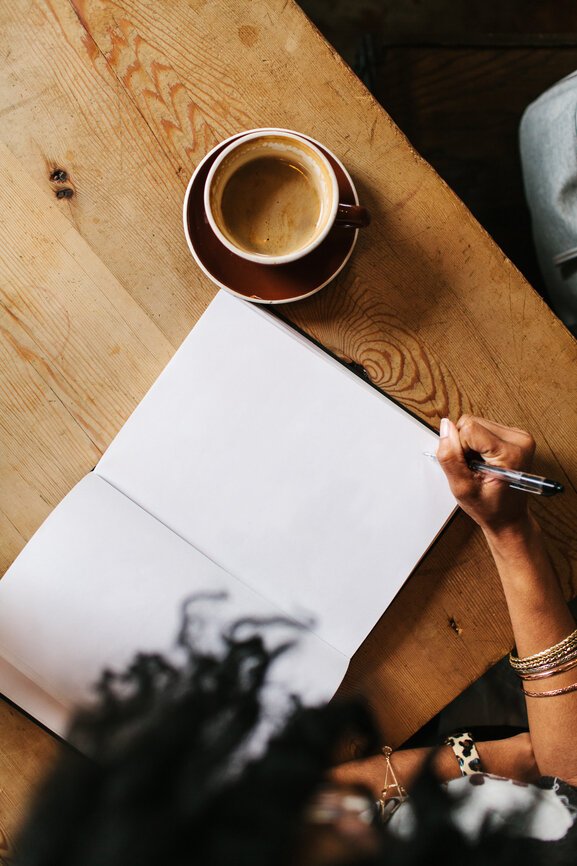
How To Use A Bullet Journal For Mindfulness
Notebooking For The Brain
In late 2019, I was gifted a blue, hardcover dotted notebook by a friend who’d been raving about bullet journaling. While traditional journaling doesn’t come naturally to me, the half-written, hodgepodge-y notes that accumulate in my iPhone have always been a silent stressor.
“We’re simplifying our lives… and bullet journaling can help us do just that.”
For example, a list I named “BOOKS 2020” does, indeed, tabulate titles I planned to read that year, but it also includes aftercare instructions for a tattoo and a list of possible people to invite to a party. Another note, with no name at all, lists the steps to a skincare regimen followed by the order of events for my sister’s wedding followed by the phrase “food processor.” Is there a more evident candidate for organizational improvement? I think not.
During an unpredictable time, many of us have turned to prioritizing our mental health, seeking self-care practices, and decluttering our day-to-days to stay afloat. From CBD to screen-free hobbies, morning routines to minimalism, we’re simplifying our lives. And bullet journaling can help us do just that.
A hybrid blend of a notebook, calendar, and to-do list, bullet journals make use of symbols like dots, dashes, arrows, and asterisks to visually organize our events, ideas, tasks, and fleeting thoughts. Simple enough, right? Well, popularity breeds personalization and now it’s not uncommon to find thousands of color-coded templates on Pinterest and over seven million uses of the #bulletjournal hashtag on Instagram. There’s also a complementary app, social network, and best-selling how-to guide.
“More than a tool for organization and scheduling, the bullet journal can also be used to support our mindfulness.”
Naturally, the bullet journal could overwhelm any interested beginner—which would defeat its original purpose. More than a tool for organization and scheduling, the bullet journal can also be used to support our mindfulness. In fact, that’s how creator Ryder Carroll describes it, as a mindfulness practice disguised as a productivity system. So here are five ways to use the tool less for future-planning and more for staying present. (Or at least a bit of both.)
Don’t Do. Be.
In bullet journaling, tasks are defined as “things you have to do” and denoted with a dot, while notes are defined as “things you don’t want to forget” and are denoted with a dash. My pages tend to be filled with a bit of both: things to buy and pay for (like floss and my credit card bill), people to call (like my therapist and a friend), and both personal errands to run and professional assignments to complete. While to-do lists are a common way to use a bullet journal, career and leadership coach Harley Frank suggests we focus less on doing and more on being.
“Try creating a ‘to-be’ list to accompany your daily planning,” Frank says. As opposed to the things we need to do during our day, this alternative list would include the ways we want to feel. She offers examples like peaceful, compassionate, grateful, light-hearted, “or any other state you’d like to embody.” According to Frank, it’s a powerful way to create mindfulness.
“As opposed to the things we need to do during our day, this alternative list would include the ways we want to feel.”
“Instead of focusing purely on your tasks and achievements, the ‘to-be’ list forces you to become conscious of your state of mind while going through each day,” she says.
Create the list in the morning and then, at night, check in and note if you were able to achieve your intended state. Frank says that over time we might notice we’ve become more mindful of our emotions and moods throughout the day. And then, she says, “You may learn to consistently cultivate exactly the feelings you’d like to experience.”
Use Your Senses
One popular coping technique for anxiety is the 5-4-3-2-1 method in which, when we experience worry or overwhelm, we tune in to our current surroundings and name five things we can see, four we can feel, three we can hear, two we can smell, and one we can taste. The exercise helps shift our focus from an unsettled mental state to the present moment instead. For this same reason, a similar approach can be used when bullet journaling.
“To maintain the intention of being present-focused while you are bullet journaling, decide to focus on your senses,” says Stephanie Thoma, a leadership & life coach and certified hypnotherapist. “Perhaps your shoulders feel loose or your breath enters and exits your mouth effortlessly.”
“Taking inventory of our environment will help bring us back to the present moment which can then inform both what we write and how we feel about it.”
Before putting pen to paper, we can take inventory of our environment. We can look at the objects that surround us and imagine what they feel like. We can touch them to confirm, noting their textures and shapes. We can close our eyes to improve our auditory attention and listen out for both the nearest and farthest sounds we can hear, whether indoors or out. We can seek the scents that we might have otherwise overlooked. And we can take a sip of water or our favorite drink and focus on both its flavor and how it feels.
All of this will help bring us back to the present moment which can then inform both what we write and how we feel about it. Maybe sending that email becomes a little less scary. Maybe we’ll realize that the task we’ve been pushing back for weeks will only take a few minutes.
Freewrite
If you’re already familiar with bullet journaling, there’s also a chance you’ve come across someone reading or raving about Julia Cameron’s best-selling book “The Artist’s Way” (even if begrudgingly). Loved by the likes of Elizabeth Gilbert and Alicia Keys, and having sold over four million copies as of 2019, the semi-spiritual self-help guide speaks to readers looking to unblock their creativity.
Of its two recommended pillars of practice, one is the daily morning exercise of longhand freewriting three pages in a notebook. The aim is to write without stopping; scrawl anything at all, things you forgot, things you fear, things you feel. Don’t overthink, censor, or edit. According to Cameron, “Nothing is too petty, too silly, too stupid, or too weird to be included.” (And if you can’t think of anything to write, “The Artist’s Way” asserts that we can simply write that truth, too.)
By getting our thoughts—all of them, any of them!—out of our minds and onto paper, Cameron says that the clearing exercise will allow its practitioners to have much more consciousness throughout their day.
“Focus your mind by writing. Set a timer and write whatever stream-of-consciousness thoughts come through for that space of time.”
Libby Micheletti, a certified career and lifestyle coach, says the same concept can be applied to bullet journaling. “For many people the practice of meditation is overwhelming,” she says. “Instead, focus your mind by writing. Set a timer and write whatever stream-of-consciousness thoughts come through for that space of time.”
And if we do decide to write on a regular basis, Micheletti says we can make that process an intentional and sensory one. “Bring your favorite beverage, go somewhere quiet, maybe even light a candle,” she says. “Set up your weekly farmers market flowers nearby, get pens you love to use, and truly enjoy and immerse yourself in the experience.”
Track Your Emotions
In addition to recording how we want to feel on a day-to-day basis, as mentioned above, Frank says that we can also use bullet journaling to track and make better sense of how we currently feel.
“Many people do not check in on their emotions proactively,” says Frank. “Instead, they wait until the feelings are so strong they can no longer ignore them.” By tuning in to our emotions earlier, Frank says we can begin to nurture them before they become overwhelming.
“Use words, colors, and pictures to indicate and represent our moods each day.”
To start, she suggests creating both a section in the journal for tracking and a regular routine—every day at the same time—to do the check-in. “Creating a consistent schedule is the best way to hold yourself accountable,” says Frank. The rest, she says, is up to us. We can use words, colors, and pictures to indicate and represent our moods each day. (If feeling stuck on where to start, look to Instagram for decorative design inspo.)
Alternatively, we can also jot down an emotion in the moment, as we feel it. Over time, we might discover persistent thought patterns or a correlation between common stimulants and our respective reactions to them. And deeper dives, perhaps guided by our personal therapists, might even reveal why we’re feeling the way we do.
Track Your Habits
In addition to my disorganized notes, I also struggle with creating habits. I meditate, but not every day—the same goes for exercising, hydration, meal-planning…I’ll stop there to save time. Habits build routines. And routines allow us to focus on the errand, effort, or enjoyment at hand—otherwise known as the present moment 😉—which is the ultimate mission of mindfulness.
“Jot the days of the month alongside the practice you want to pursue. As the days pass, mark each time you achieve the act.”
To create (and stick to) habits, tracking them can help. According to James Clear, author of the New York Times best seller “Atomic Habits”, tracking our desired tendencies not only serves as a visual reminder to act on them, but keeps us motivated to do so as we often don’t want to break a “streak.” Clear also notes that, in the moment, it feels satisfying to record a success.
To begin tracking habits in a bullet journal, jot the days of the month alongside the practice you want to pursue—whether it be reading, cooking, learning a language, or all of the above. As the days pass, mark each time you achieve the act. (If in need of a template, we love this gorgeously watercolored style used by television writer-producer Franchesca Ramsey, but you can also find thousands of design ideas on Instagram.)
Above all else, whether we choose to use a bullet journal for mindfulness or life management, it remains an accessible tool that can be adapted and altered any way we see fit. And the more individualistic approach we take to using one, the better it will serve us. (We personally love these dotted notebooks with customizable covers, hard or soft.) And if you need some guidance on getting started, here are some journal prompts for both emotions and creativity.
“Whether we choose to use a bullet journal for mindfulness or life management, it remains an accessible tool that can be adapted and altered any way we see fit.”
Have you tried using a bullet journal to support a more mindful day? Let us know your favorite tips in the comments below! 📝
RELATED READING
Danielle Cheesman was born and raised in New Jersey, where she lived until moving to Philadelphia to study journalism at Temple University. She has spent her years writing and developing editorial visions for music, art, and lifestyle brands. Now residing in Los Angeles, you can usually find her taking pictures, making playlists, or cuddling her pup. Say hi on Instagram!
